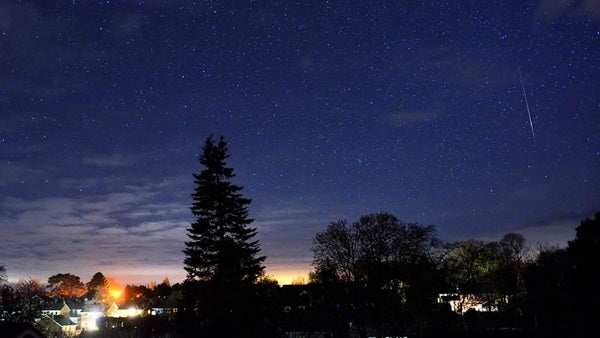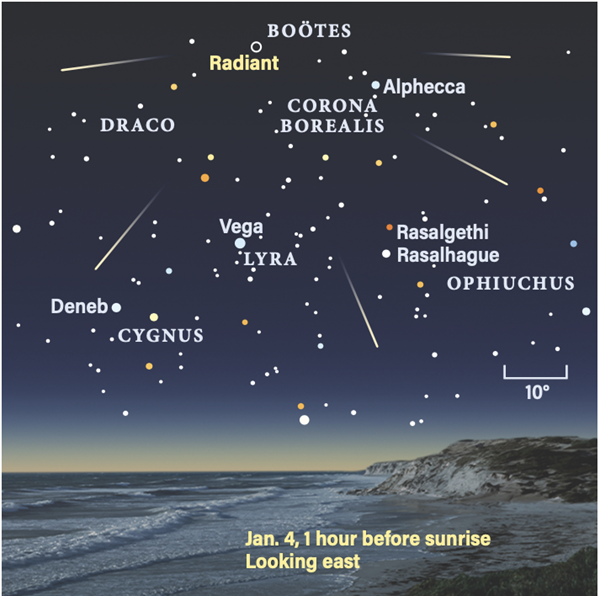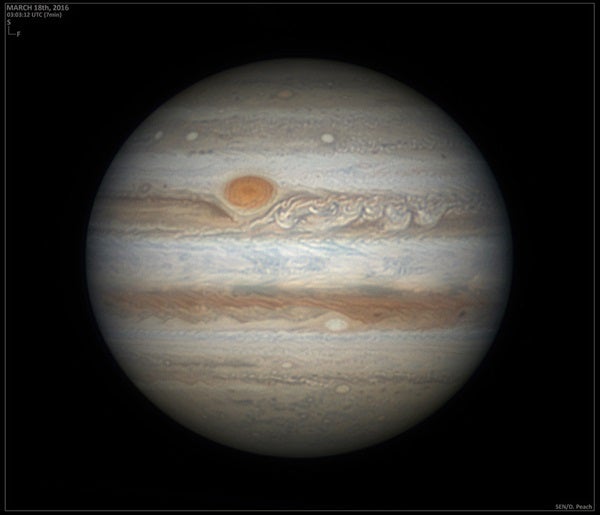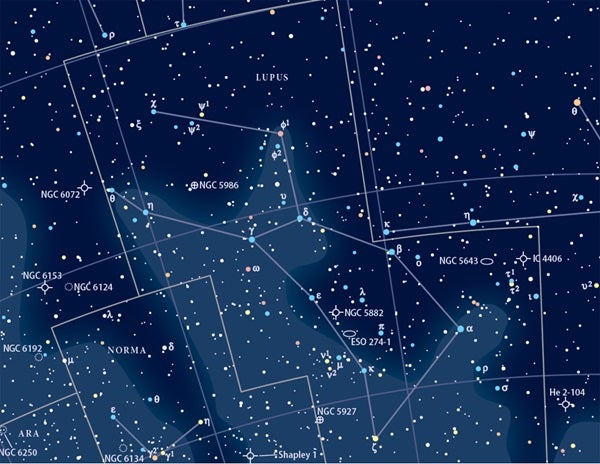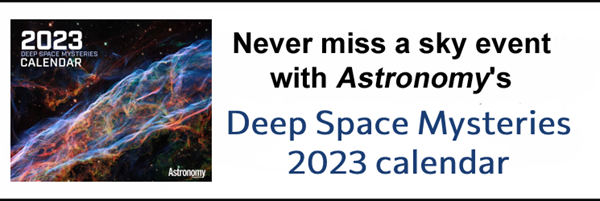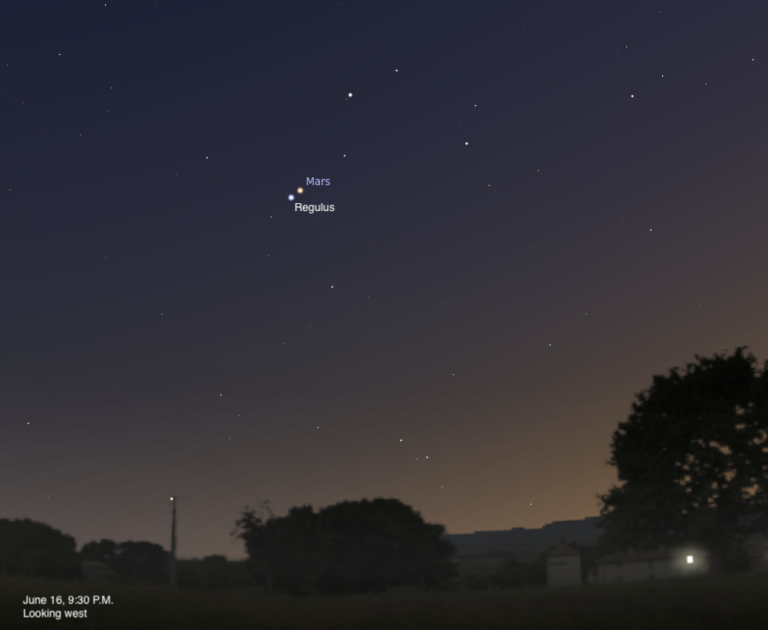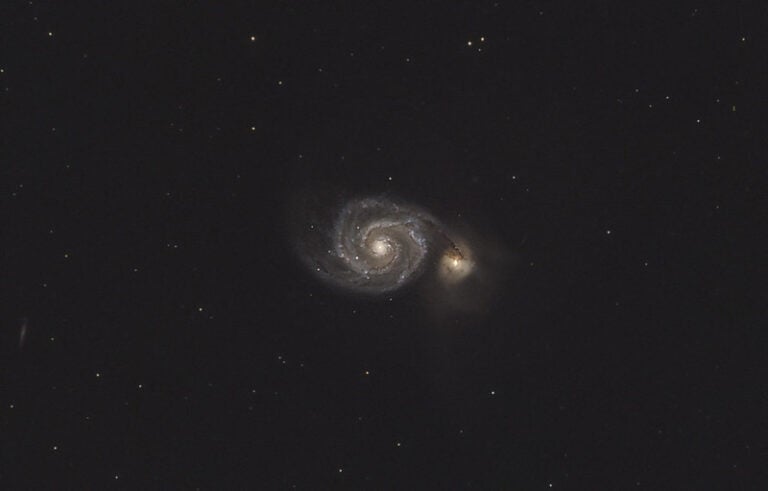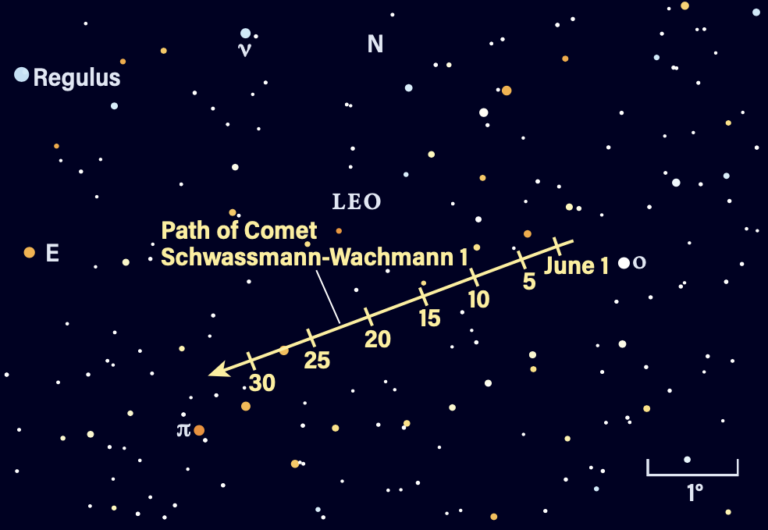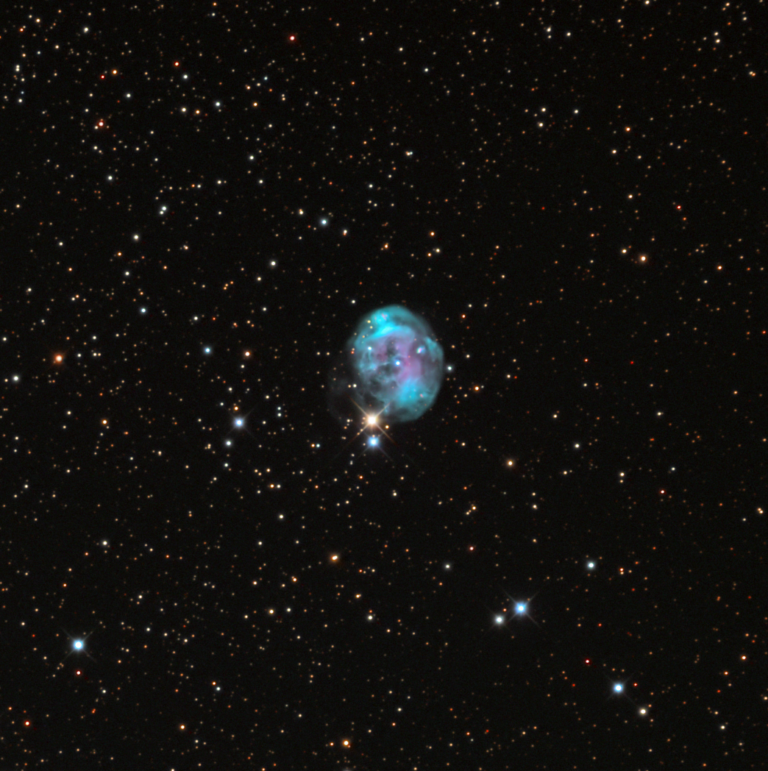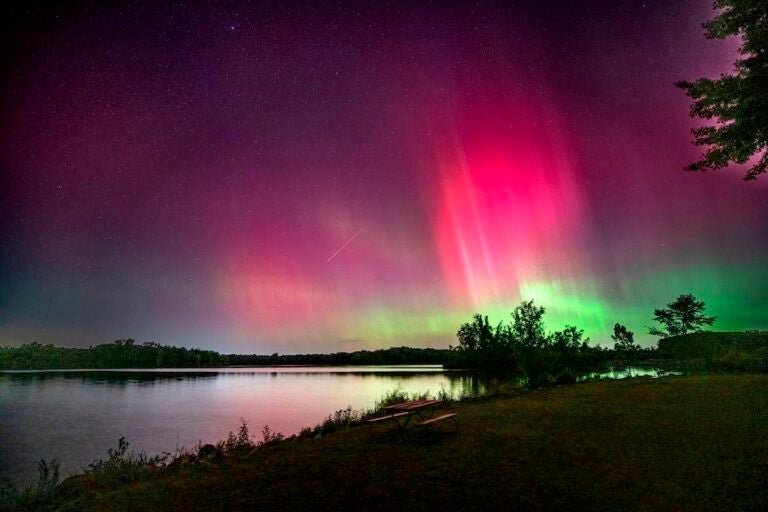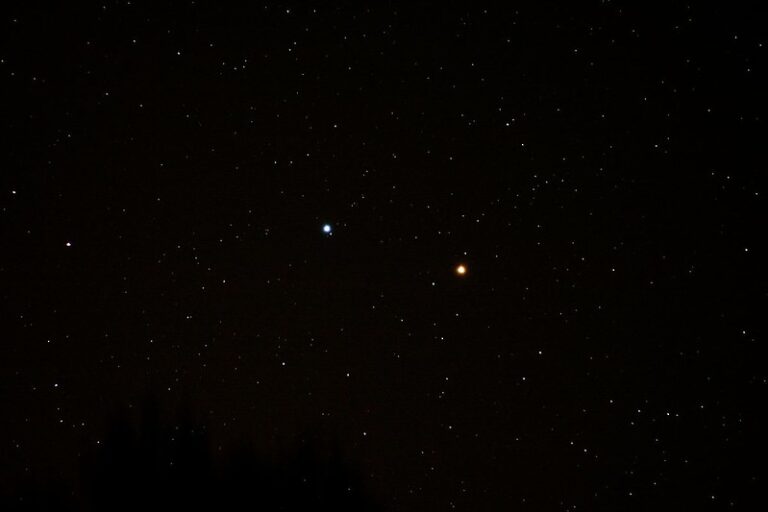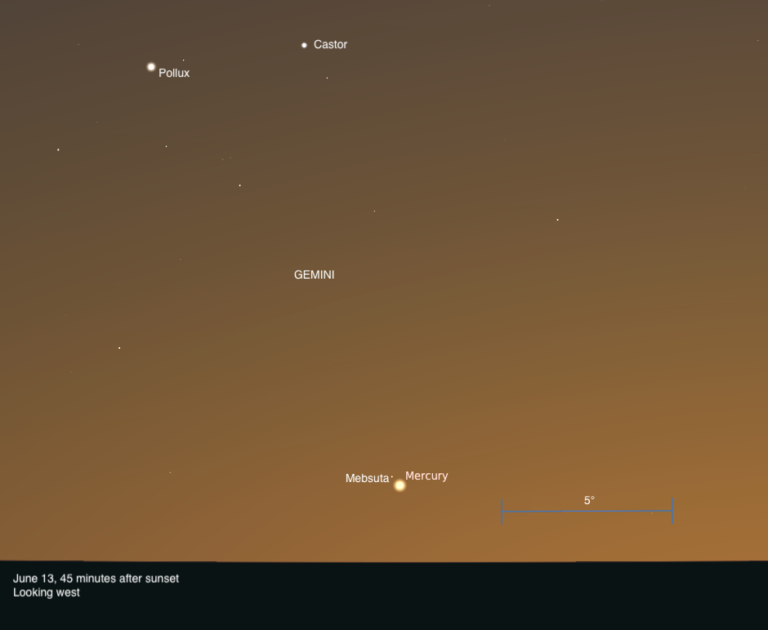Friday, December 30
Camelopardalis is one of several circumpolar constellations in the north, swinging around Polaris — the North Star — in a circle, night after night. This evening after sunset, the Giraffe is on the upswing, rising in the north to the right of Polaris.
Camelopardalis is home to a particularly famous asterism: Kemble’s Cascade. Discovered several decades ago by amateur astronomer Father Lucian Kemble, this waterfall-like pattern lies about 6° west of the center of a line drawn between 4th-magnitude Alpha (α) and Beta (β) Camelopardalis. You can spot it readily through 7x binoculars, though any small telescope will easily net you this prize as well.
The cascade comprises just over a dozen stars between magnitudes 7 and 9, appearing to flow (or cascade — get it?) from northwest to the southeast. Roughly midway down the line is a brighter 5th-magnitude star. And, at the end of the line (to the southeast) lies the open star cluster NGC 1502. Kemble — and many after him — imagined this cluster as the “spray” thrown up as a waterfall (the line of stars) ends its tumble into a pool of water.
This asterism — and constellation — is a favorite of Astronomy columnist Phil Harrington, whose column often features Kemble’s Cascade and other treasures found in the Giraffe.
Sunrise: 7:22 A.M.
Sunset: 4:44 P.M.
Moonrise: 12:15 P.M.
Moonset: 12:16 A.M.
Moon Phase: Waxing gibbous (57%)
*Times for sunrise, sunset, moonrise, and moonset are given in local time from 40° N 90° W. The Moon’s illumination is given at 12 P.M. local time from the same location.
Saturday, December 31
Before your New Year’s Eve celebration begins, look southwest as twilight falls to catch a last glimpse of Mercury and Venus together. Soon, Mercury will dim and disappear completely from the evening sky, only to reappear in the morning later this month.
Some 30 minutes after sunset, the two planets are roughly 6° high; they came closest just a few days ago and now stand 4° apart. Mercury, which sits to Venus’ west, has now dimmed to magnitude 1.3, making it tricky to catch in the Sun’s fading light. Binoculars or a small scope — use these only after the Sun has completely disappeared — should bring it out, showing the planet’s small, 9″-wide disk. It is now just 17 percent lit.
Venus, by contrast, is a brilliant magnitude –3.9, making it easy to pick out against the darkening sky. The larger planet is now 96 percent lit and spans 10″, just a hair wider than Mercury’s apparent width.
To the pair’s upper left (east) is first Saturn (magnitude 0.8) in Capricornus, then Jupiter (magnitude –2.4) in Pisces. Keep going across the sky, and you’ll land on Mars (magnitude –1.3) in Taurus. The spread offers a lovely view across the solar system, showing the planets lined up along the ecliptic, which tilts sharply relative to the evening horizon at this time of year.
And, if you’ve got those binoculars or telescope, you can even add Uranus and Neptune into the mix. The former is magnitude 5.7 and resides in Aries, while the latter is magnitude 7.8 and sits in Aquarius.
Sunrise: 7:22 A.M.
Sunset: 4:44 P.M.
Moonrise: 12:39 P.M.
Moonset: 1:23 A.M.
Moon Phase: Waxing gibbous (68%)
Sunday, January 1
Happy 2023! Starting today, Astronomy is pleased to announce that Sky This Week is brought to you by Celestron, a renowned leader in the optics industry for decades. Be on the lookout for more exciting observing content, brought to you through a partnership between Astronomy and Celestron, throughout the year.
The Moon passes 0.7° north of Uranus at 5 P.M. EST. You’ll find the pair in Aries, high in the southeast an hour after sunset. The bright Moon, now 79 percent lit, will pretty readily drown out faint Uranus’ magnitude 5.7 glow, which is just at the edge of naked-eye perception in dark conditions. To spot the distant ice giant, use binoculars or a telescope to aid in finding the 4″-wide planet just to the right of the Moon in the sky.
You can even watch our satellite slowly pull away over the next few hours, widening the gap between itself and Uranus as the Moon travels toward neighboring Taurus, currently hosting bright Mars as a showpiece of the winter sky. Directly between the Moon and Mars are the Pleiades (also cataloged as M45), a small, dipper-shaped cluster of young stars. (Though don’t mistake these for the Little Dipper, which is much bigger and resides in the north!)
Sunrise: 7:22 A.M.
Sunset: 4:45 P.M.
Moonrise: 1:05 P.M.
Moonset: 2:27 A.M.
Moon Phase: Waxing gibbous (77%)
Monday, January 2
About two hours after sunset, the solar system’s most distant planet, Neptune, still lies relatively high in the southwest. At magnitude 7.8, you’ll certainly need some optical aid to spot it — binoculars or any telescope will do. You’ll find the planet in Aquarius, located between two 7th-magnitude stars. To find them, first locate 4th-magnitude Phi (ϕ) Aquarii. From there, jump 5° northeast and look for a parallelogram of four stars, each about 1° apart. Tonight, Neptune is closest to the northeasternmost star in this shape. The planet will close in on this distant sun over the next few days, passing just 6′ due south of it in about a week.
But the solar system has more in this region to explore: Drop about 7° southwest and you’ll land on a trio of 4th-magnitude stars. These are, from west to east, Psi1 (ψ1), Psi2 (ψ2), and Psi3 (ψ3) Aquarii. About 2.7° due south of Psi1 is 8th-magnitude 4 Vesta, the main belt’s second most massive asteroid. Vesta will follow a northeasterly path this month, skimming closer to the three stars in a few days and then heading up toward Pisces, passing due south of Neptune around midmonth.
Sunrise: 7:22 A.M.
Sunset: 4:46 P.M.
Moonrise: 1:34 P.M.
Moonset: 3:33 A.M.
Moon Phase: Waxing gibbous (84%)
Tuesday, January 3
The Moon passes 0.5° south of Mars in Taurus at 3 P.M. EST. By an hour after sunset tonight, they are 4° apart, forming a nice east-west line on the sky starting with the Moon on the left, Mars in the middle, and the Pleiades star cluster on the right. Below them hang the Hyades, a sparse open star cluster sprinkled across Taurus’ nose, and magnitude 0.9 Aldebaran, the Bull’s luminary. Compare both its brightness and color with that of Mars above it — the Red Planet shines with a similar hue, though Aldebaran is “red” because of its cool temperature, while Mars’ rust-laden dirt reflects sunlight to create its color. Mars is also currently much brighter, now magnitude –1.2.
The Quadrantid meteor shower peaks late this evening for U.S. observers. It’s one of wintertime’s best shows, though the Moon will interfere this year. Nonetheless, the high hourly rate means taking a stab at spotting shower members is worthwhile. The best time to watch for Quadrantid meteors will be early next morning, so keep reading to learn more.
Sunrise: 7:22 A.M.
Sunset: 4:47 P.M.
Moonrise: 2:07 P.M.
Moonset: 4:37 A.M.
Moon Phase: Waxing gibbous (91%)
Wednesday, January 4
As we mentioned yesterday, the best time to look for Quadrantid meteors is early this morning in the hour or two before sunrise and after the Moon has set. An hour before the Sun peeks over the horizon, the shower’s radiant is some 66° high. It’s located in Boötes, which might seem odd, given that meteor showers are named for the constellation in which they appear to originate. But this particular shower’s original home of Quadrans Muralis is not one of the 88 modern-day constellations recognized by the International Astronomical Union (IAU).
The zenithal hourly rate is expected to top out around 110 meteors per hour, meaning there should be at least a few good shooting stars visible, even with the Moon’s light suffusing the sky. Particularly bright meteors should really stand out; look somewhat away from the radiant itself, as meteor trails are shortest near the radiant and longer to either side of it.
Earth reaches perihelion, the closest point to the Sun in its orbit, at 11 A.M. EST today. At that time, our planet will sit 91.4 million miles (147 million kilometers) from our star. Nonetheless, it’s one of the coldest times of the year for Northern Hemisphere residents — that’s because although Earth might be closer to the Sun, the tilt of our planet’s axis affects the amount of incident sunlight this hemisphere receives at this time of year, causing temperatures to drop.
Sunrise: 7:22 A.M.
Sunset: 4:48 P.M.
Moonrise: 2:46 P.M.
Moonset: 5:40 A.M.
Moon Phase: Waxing gibbous (96%)
Thursday, January 5
Break out the telescope early this evening to catch some action at Jupiter. The solar system’s largest planet is currently in Pisces, some 50° high at sunset. It glows a bright magnitude –2.3 and spans a worthy 39″ in the sky. Now is the best time to check out the planet, as it will begin to shrink slightly as it grows farther away over the course of the month.
As the sun sinks below the horizon in the eastern half of the country, Europa’s shadow is already traveling from east to west across the jovian cloud tops, trailed by the planet’s Great Red Spot (GRS). The shadow slips off the disk around 7:35 P.M. EST, about an hour after the GRS crosses the planet’s central meridian.
Europa itself lies west of the planet, as does Callisto; the latter is much farther out. To Jupiter’s east are Ganymede, which appears closest to the planet, and Io. If you opt to keep watching into tomorrow morning, Ganymede will draw closer to Jupiter’s eastern limb, beginning a transit of its own around 2:25 A.M. EST on the 6th.
Sunrise: 7:22 A.M.
Sunset: 4:49 P.M.
Moonrise: 3:33 P.M.
Moonset: 6:38 A.M.
Moon Phase: Waxing gibbous (99%)
Friday, January 6
Full Moon occurs at 6:08 P.M. EST, shortly after sunset. The January Full Moon is also called the Wolf Moon. It will stand in the sky until shortly after sunrise tomorrow morning.
But did you know there’s another wolf in the sky? To catch Lupus the Wolf, you’ll need to get up early, as this star pattern rises about two hours before sunrise. And, depending on your location, some or most of Lupus may never clear the horizon at all — if you live at latitude 60° north or higher, you won’t see any of Lupus’ stars. Those south of latitude 35° north can see the entire pattern.
Lupus sits south of Libra, west of Scorpius, and east of Centaurus. The Wolf’s alpha star is a bright, blue-white, magnitude 2.3 sun that lies in the constellation’s southern region. Although it has no formal IAU name, it is historically called Kakkab. Slightly northeast is magnitude 2.7 Beta Lupi, more easily seen from higher latitudes. And in drawings, 4th-magnitude Chi (χ) Lupi depicts the Wolf’s jaw or nose.
This constellation is full of beautiful deep-sky objects to enjoy — see the chart above — though they’ll be challenging during the Full Moon. So, we’ll return some other time to find them!
Sunrise: 7:22 A.M.
Sunset: 4:50 P.M.
Moonrise: 4:26 P.M.
Moonset: 7:30 A.M.
Moon Phase: Full

